This insightful article offers a comprehensive guide to deciphering the subtle signs of a fish’s deteriorating health and understanding the underlying causes. From behavioral changes to physical symptoms, learn how to discern whether your fish is experiencing a temporary ailment or facing a more serious, life-threatening condition.

It’s never easy to tell if your fish is dying or if the signs it’s exhibiting are due to something else entirely.
Sometimes a fish may act in the same way it would if it was sick.
Lack of appetite, for instance, is one of the most common symptoms of a dying fish. However, this doesn’t necessarily mean a fish is about to perish. A fish may refuse to eat just because it was overfed. For this reason, I’ve written a guide that will spare you unnecessary confusion.
Here’s how to know if your fish is dying for sure.
How to tell if your pet fish is dying?
Fish with impaired health can exhibit a myriad of symptoms.
Some can be seen by the naked eye, while others aren’t so easy to spot.
As with any other pet, when fish are about to pass away, they start to behave in unusual ways.
A sick fish, for instance, may become sluggish and spend more time at the bottom of the aquarium.
That’s why the easiest way to tell if a fish is sick or indeed, dying, is to monitor its behavior:
When a fish is about to die it may lack appetite and become increasingly lethargic. These symptoms are usually a sign of an advanced stage of sickness. Treating the illness as soon as possible could increase the survival chances of your fish.
Behavioral changes, however, aren’t the only indicators of poor health in pet fish.
What are the most common signs of a sick fish?
Pay attention to the following if you’re concerned about your pet:
1. Fading colors

Fading body colors are one of the tell-tell signs of a stressed fish. Typically, when a fish feels stressed it stops eating.
Because fish are unable to produce pigments of certain types, their skin color is in great part determined by the food they eat. Consequently, when a fish stops eating, it loses the pigments which give off its vibrant colors.
Anyway, check if there are any other health issues present.
If the discoloration is combined with lethargic behavior, for instance, your fish is most probably ill.
Author’s note: Sometimes, however, a fish might start to lose its colors due to genetic factors. Some Betta fish who carry the Jumping Marble gene, for example, can change their color patterns multiple times during their lifetime.
2. Raised white dots on body
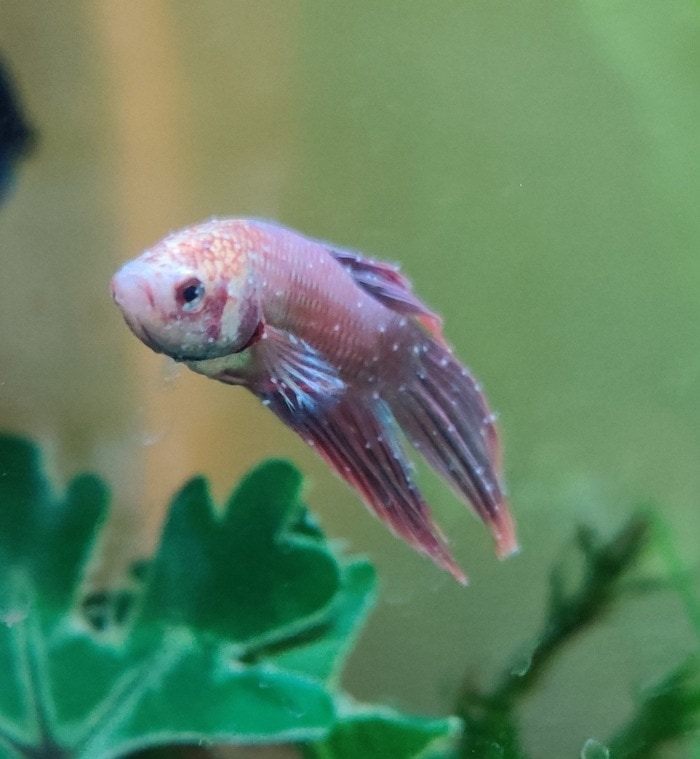
The most common reason why a fish’s body becomes covered in white spots is an external parasite called Ichthyophthirius multifiliis or Ich. Ich greatly damages the gills and skin of a fish, by directly penetrating its skin.
This disrupts the osmoregulation of the fish which leads to a host of other health issues.
If left untreated, Ich could kill a fish in less than 4 days. White blotches, however, could also be a result of a milder bacterial infection.
Whatever the reason, you shouldn’t leave your pet to suffer any more than it needs to.
Consult your vet for the appropriate treatment in case you notice any unusual white spots on the body of your fish.
3. Bloating

Bloating or Dropsy, as it’s most commonly referred to, is caused by the accumulation of fluids in a fish’s body.
Liver dysfunction, and parasitic or bacterial infections, are among the chief suspects for this condition. Fish experiencing Dropsy, usually have an unnaturally bloated abdomen which gives them a pine cone look.
Some other typical signs of bloating include protruding scales, bulging eyes, and pale gills.
Dropsy is treated differently, depending on the underlying issue at play.
Some of the most commonly used treatments include water changes, salt, and antibiotics.
4. Gasping for air

Is your fish constantly at the top of your water column?
Is it having trouble breathing?
Then it may be in desperate need of some oxygen.
Hyperventilating fish swim to the surface of an aquarium when there isn’t enough oxygen in the water.
If the water in your tank contains high amounts of ammonia or nitrite, the pollution can damage the gills of your fish. Gills play a major role in oxygen intake for fish.
This could lead to seemingly gasping helplessly near the water surface.
In those cases, it’s not a bad idea to pull out that liquid test kit you have at hand if you notice your pet is struggling for air.
Measure the aquarium’s water parameters and see if something went wrong with its Nitrogen Cycle.
A “cycled” aquarium should show the following water test results at all times:
- 0 ppm of ammonia;
- 0 ppm of nitrite;
- Upwards of 5 ppm of nitrate.
Another factor you should always consider if your fish is having difficulties breathing is stress.
Fish are fickle creatures and even small changes in their environment could stress them out.
Sometimes, all your fish needs to become stressed is a new tank mate, but I’ll get more into that in the following sections.
5. Decreased appetite
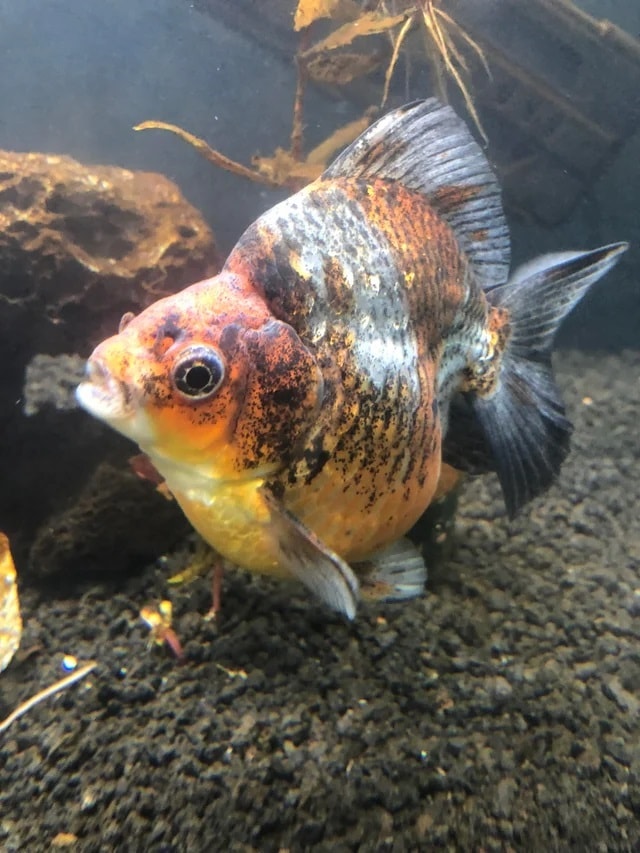
Decreased appetite should be taken as an indicator of poor health if a fish hasn’t eaten for at least a few days. A hungry fish is usually a healthy one.
If your pet suddenly stopped eating, then it’s highly probable there’s something amiss with its environment.
The pH levels of your water might be askew or there could be too much waste in the form of ammonia or nitrite.
In some cases, the lack of hunger could even be due to parasitic infections such as Ich.
Author’s note: A healthy fish can go up to a week or more without food with no issues.
However, if your fish is deliberately denying food then there’s an issue.
6. Sluggishness

Unless it’s sleeping, your fish shouldn’t be idly sitting around at the bottom of your tank for hours on end. This only applies to species that are not bottom dwellers by nature.
A sleeping fish will have at least some gill movement. They will also move their fins here and there. To make sure your fish is not already dead use your fish net GENTLY poke it…
Even direly sick fish will react to touch. If you’re fish is not swimming but is still alive then there’s still a chance to save it.
Healthy fish like to explore their environment and rarely spend much time at the bottom.
If a fish spends more than a few hours at the bottom, it most probably means it’s sick.
Apart from being ill, fish may become lethargic due to temperature fluctuations.
Unlike people, a fish’s body temperature will match that of the water surrounding it. This directly influences its metabolic rate and behavior.
A fish living under its optimal temperature range will have a slower metabolism resulting in sluggish movements.
7. Buoyancy control issues
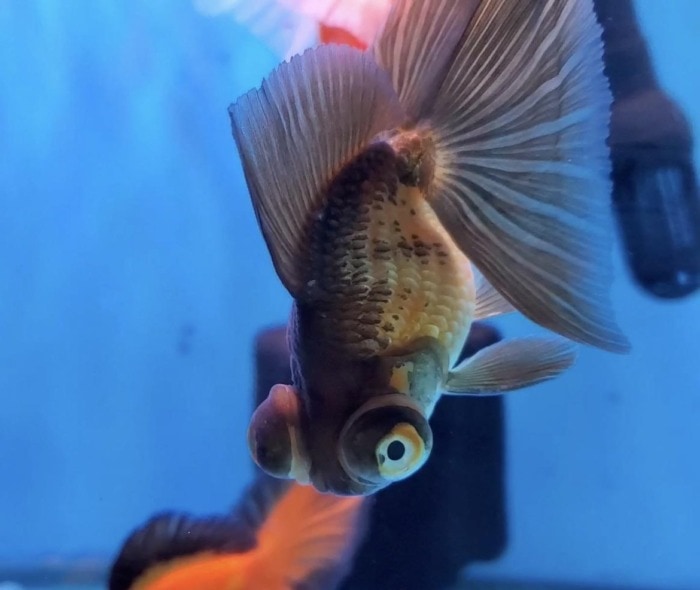
This one is also easy to spot. A fish with buoyancy control issues will swim upside down or sideways.
This might seem like a scene from the movie Inception, at first, but you shouldn’t take it lightly.
Left unchecked, buoyancy control issues could elevate the stress levels of your fish and eventually kill it.
The reason behind such odd behaviors is usually swim bladder disease.
The swim bladder is a gas-filled organ that helps fish float.
When affected, the fish’s ability to float gets impaired.
Swim bladder disease could have many potential causes.
Overeating, constipation, parasites, or bacterial infections being the most common ones.
And to clarify:
Dead fish only float after being dead for a couple of days.
So, as obvious as it seems, even if your fish has swim bladder issues and is seemingly floating, if it still moves around then it is not dead.
Since fish are denser than water they will immediately sink right after dying.
After a couple of days, gasses from bacterial activities start building up in the fish’s body and makes it float again.
What causes sickness or death in fish?
In the vast majority of cases, a fish becomes sick because of stress.
A stress-free fish has a robust immune system that can fend off almost any illness and infection. That’s why keeping an environment free of stress is of utmost importance for the health of any fish.
If you want to maintain a trouble-free aquarium, pay attention to the following stress-inducing factors:
- Fish compatibility. Keeping incompatible fish together is a recipe for disaster. When there are two or more incompatible fish in a tank, they might compete for territory and fight with each other. In other cases, fish with a milder temperament might be attacked by more aggressive ones. If you want your fish to coexist peacefully, make sure they’re compatible in the first place.
- Contamination. Water to fish is like what air is to people. If you’re constantly exposed to polluted air, you may develop a respiratory illness sooner or later. It shouldn’t come as a surprise then, that contaminated water stresses fish and makes them susceptible to infections and illnesses. Perform regular water tests to be sure your aquarium water isn’t contaminated.
- Overcrowding. Anyone who’s been to a crowded bar or beach can attest that it’s not the most comfortable experience. Having to worry about bumping into strangers might be even described as stressful by some. The same principle applies to fish. When there are too many fish in a tank, they naturally become stressed by the lack of personal space.
- Inappropriate water temperatures. Most fish aren’t used to temperature changes. Any fluctuation, be it under or over the specific temperature range of your fish, elevates their stress levels.
You can save this checklist for future reference.
Is my pet fish suffering?
It’s easier to tell if our land-based pets are suffering because we can hear their cries for help.
Aquatic pets, on the other hand, have no way of reaching out to us.
So how can we tell if we are actually causing suffering by prolonging their lives needlessly?
If you have observed any of the aforementioned signs in your pet, then it’s most probably unhappy and in pain.
One telltale sign a pet fish is suffering is physical changes in the body or behavior.
Physical changes are displayed by things like fastened gill movement as if the fish is gasping for air, erratic swimming and twitching, reddened or otherwise inflamated gills, wounds or raptured fins, and a pale color.
Also, drastic changes in behavior like refusing to swim or eat would also mean your fish is not feeling well enough to perform its vital duties.
A struggling fish will always display some of these symptoms.
What actions to take to help a dying pet fish?
There are basically three steps to take after you notice your pet fish is not well. These are:
- Diagnose what made the fish fall ill.
- Treat the fish or the aquarium water.
- Euthanize the fish if nothing else helps.
There’s more to each of this steps, so let me explain each one if you’re new to this:
1. Diagnose your fish.

In any case, only a veterinarian can properly diagnose your pet fish so consider consulting with a specialist.
But if you want to make sure it’s not some super specific disease and rule out general fish keeping mistakes you should immediately measure the water parameters in your aquarium.
Use your liquid test kit to make sure there’s no ammonia or nitrite in your aquarium water. Both ammonia and nitrite should be 0 ppm in a freshwater aquarium. Saltwater fish don’t get affected by nitrite that much.
If there’s any of either, start working on removing it right away by changing a portion of the toxic water.
Also, check your fish tank’s water thermometer. Did the temperature drop abruptly? Is the tank’s heater working properly? Was the night before a really cold one? Do you even have a reliable separate thermometer, aside from the one built in your heater?
The answers to these questions will help you find out if the fish has fallen ill because of a temperature shock.
Finally, it’s very rare the case that your fish die of old age.
Only very experienced fish keepers get to see their fish dying from being too old.
The fact that you don’t know how to recognize a sick fish, and are here reading this article, means that maybe you’re too inexperienced and that something else is wrong with your fish.
That’s unless you’re looking after fish with short lifespan like the perennial killifish, for example.
Many species of fish live for at least 5 years upon proper care.
Did you have yours for more than 5 years?
Unfortunately, the signs of a fish dying from old age are very general in nature and overlap with symptoms from other illnesses. A fish that’s about to pass away from old age is lethargic, has no appetite and becomes pale.
2. Treat the sick fish or stabilize the aquarium water.
If your fish doesn’t display mysterious new spots or dots, lesions, discolored patches, wounds, rotting fins, bloating or fuzzy formations on its body then the issue likely comes from its environment.
All of these are symptoms of specific diseases, parasites, bacterial and fungal infections.
These conditions could still be a result from bad aquarium water, but need to be treated separately, inside the body of the fish.
Obviously, the best way to target-treat such infections and diseases is with the help of a veterinarian.
That being said, Aquanswers has many articles that you can use as general guidance on what your fish is ill from and how to approach the treatment.
Besides specific infections and parasites the most common thing that may harm a pet fish is bad aquarium water.
If you’re a beginner in the hobby and are not familiar with good water parameters then bad aquarium water is likely what’s affecting your dying pet fish. I’m not pointing fingers here, we all learn with time, and what’s important is to figure out what’s wrong with your fish.
Stabilizing the water parameters of your aquarium usually comes down to partial water changes, adding beneficial bacteria to the tank and having a properly working heater and filter.
Water acidity, also known as pH, is a whole different monster that should not be messed with. If you’re aquarium experiences rapid pH changes then you’re doing something cardinally wrong. That something is typically not using a good source of water.
Finally, let’s address old fish again.
Unfortunately, in the rare case your fish is actually dying of old age, there’s just nothing you could do to save it.
In such dire times, it comes down to watching your pet die a slow miserable death, or terminating its suffering in the most humane way possible.
3. Euthanize your fish if nothing else helps.
Covering such controversial topics is never easy.
Each pet owner deals with the death of their fish differently.
Some might choose to end the suffering of their pets without hesitation, while others prefer to let nature run its course.
That’s why this is a personal choice that you as the pet owner have to make.
If you’ve tried fixing the aquarium water and used some medicine to treat an infected fish without results then maybe it’s time for you to decide what comes next for your pet.
One simple way to euthanize a fish in a humane way is with what’s known as Clove Oil.
You’d want to find 100% Clove Oil which is typically available over the counter.
The 100% solution is the right one for the job.
Clove oil is basically a sedative but in larger doses it can put a fish to sleep peacefully.
To euthanize a dying fish you can follow these steps:
- Fast the fish for 24 hours.
- Fill a container with 2 gallons of aquarium water from your tank.
- Transport the dying fish in that container.
- Add 0.4 ml of Clove oil per liter of water or 1.5 ml per US gallon to the container over a 5 minute period.
- Keep the fish in the container with the solution for at least 20 minutes after any movement has ceased.
It kind of hurt when I was typing this but sometimes we gotta do what we gotta do. Stay strong.
My final thoughts
Don’t feel discouraged if your fish is dying!
There likely is still hope, assuming that you manage to act quickly enough.
And in case nothing works, you could unload your burden by sharing your story down in the comments.
I have found that sharing always helps alleviate the pain of losing a beloved pet.

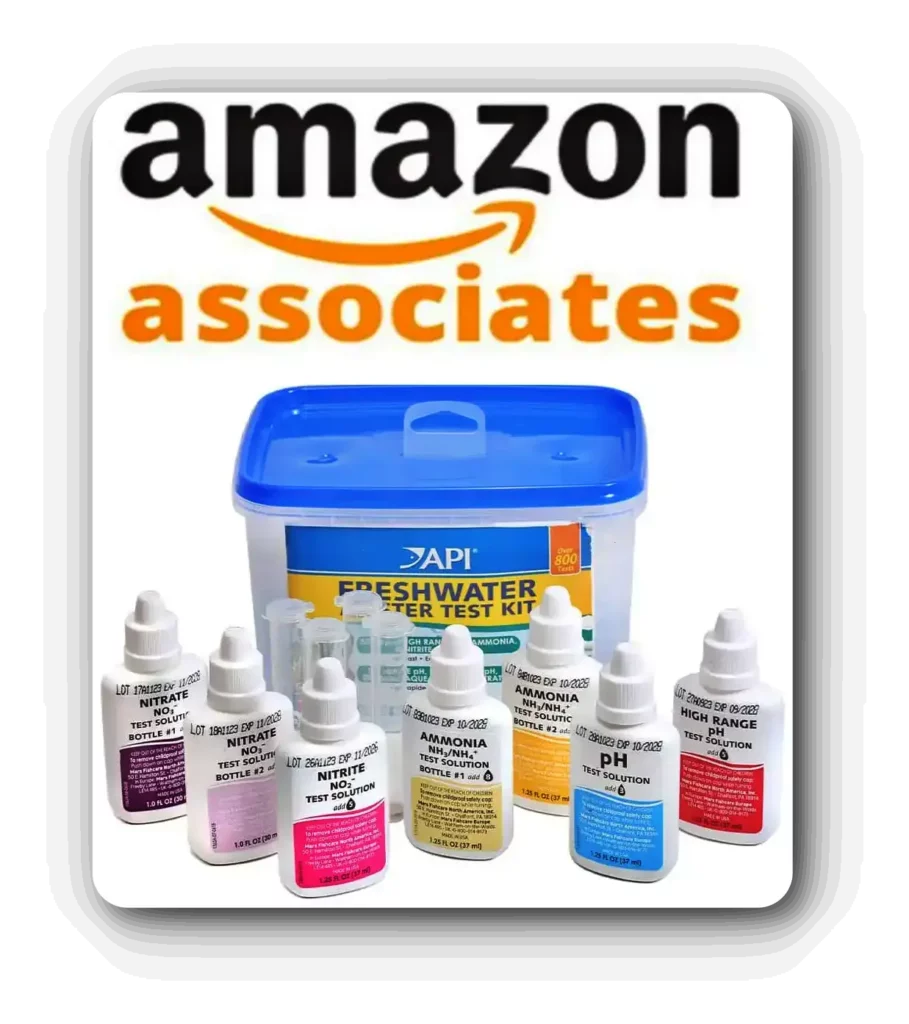

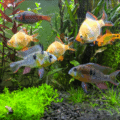

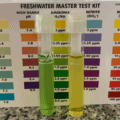
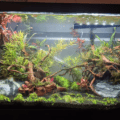



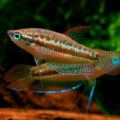

Almost two years ago I brought ten gold fish to give to my turtle. Instead of giving it all ten I kept some. Some of them passed away except three which have grown in size this year. This morning one of them passed and I wrapped it in a paper towel and flushed it. After removing most of the water from the tank, I removed the two fish from the tank to wipe some residue off the sides of it. I them refilled the tank added some water conditioner I put the fish back in it. I’m very sad because of the length of time I cared for them even gave them names..Nemo, Eeyore, and Greystoke. We lost Nemo today and I can tell that the others are missing their tank mate. How long should I wait to get them a new tank mate
Hi, Andrea,
As long as the tank remains cycled, you can add one new fish to it safely. Test the water using a test kit and if it shows 0 ppm of ammonia, 0 ppm of nitrite, and more than 5 ppm of nitrate then the tank is cycled.
Best,
Momchil